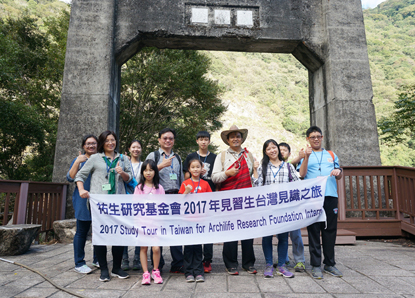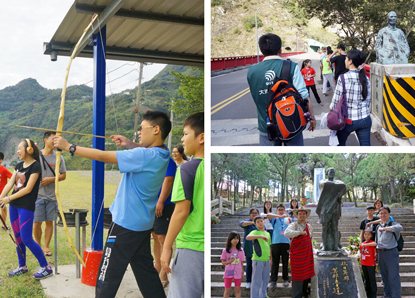Sketch of Archilife Study Tour, November 2017Date: 2017-12-04
Section: Activity |  11月份見識之旅活動,於2017年11月4日由呂明澐小姐帶領7位祐生見習生及家長們,進行南投賽德克文化暨霧社事件探索之旅。出發當日天氣晴朗,見習生們及其家長皆準時集合並出發。活動開始之初,領隊呂明澐小姐提醒本次活動注意事項及觀察重點,先行建立見習生的背景知識。 11月份見識之旅活動,於2017年11月4日由呂明澐小姐帶領7位祐生見習生及家長們,進行南投賽德克文化暨霧社事件探索之旅。出發當日天氣晴朗,見習生們及其家長皆準時集合並出發。活動開始之初,領隊呂明澐小姐提醒本次活動注意事項及觀察重點,先行建立見習生的背景知識。
For the study tour of November 4, 2017, Ms. Lu Ming-yun led seven ARF interns and their parents on a tour to discover Seediq culture and the Wushe incident in Nantou. It was sunny on the day of the tour, and the interns and their parents were on time for the departure. At the start of the day's activities, team leader Ms. Lu Ming-yun reminded everyone about things to note and what to observe, and provided the interns some general background knowledge.
 本次行程以探索霧社事件為主軸,由賽德克第五代頭目擔任導覽老師。自高鐵站行車前往清流部落時,沿途介紹賽德克族的傳統文化與生活習慣,並說明賽德克.巴萊的意思係「真正的人」。抵達清流部落後,頭目講述在霧社事件後,日人為防範霧社各族群之間的仇怨報復,將倖存族人遷居至川中島,即今日的清流部落,以便後續管理。隨後至霧社事件餘生紀念館,首先,頭目闡明霧社事件發生的歷史背景及原因,接著描述事件發生之始末、作戰路線和各方參與人數,日方最後透過以夷制夷、大量的彈藥投射,迫使參加起義的各社投降。配合看板上的歷史照片,在在顯示參戰原住民為守護祖上傳承下來的文化及族人尊嚴,雖深知不敵日軍,仍奮力作戰抵抗的精神。離開餘生紀念館後,乘車前往霧社地區,沿途經過人止關,頭目指出道路兩旁險峻的山壁,說明當時霧社原住民以此天險成功阻止日軍入山,然卻為之後霧社事件埋下爆發的種子。 本次行程以探索霧社事件為主軸,由賽德克第五代頭目擔任導覽老師。自高鐵站行車前往清流部落時,沿途介紹賽德克族的傳統文化與生活習慣,並說明賽德克.巴萊的意思係「真正的人」。抵達清流部落後,頭目講述在霧社事件後,日人為防範霧社各族群之間的仇怨報復,將倖存族人遷居至川中島,即今日的清流部落,以便後續管理。隨後至霧社事件餘生紀念館,首先,頭目闡明霧社事件發生的歷史背景及原因,接著描述事件發生之始末、作戰路線和各方參與人數,日方最後透過以夷制夷、大量的彈藥投射,迫使參加起義的各社投降。配合看板上的歷史照片,在在顯示參戰原住民為守護祖上傳承下來的文化及族人尊嚴,雖深知不敵日軍,仍奮力作戰抵抗的精神。離開餘生紀念館後,乘車前往霧社地區,沿途經過人止關,頭目指出道路兩旁險峻的山壁,說明當時霧社原住民以此天險成功阻止日軍入山,然卻為之後霧社事件埋下爆發的種子。
Focusing on discovering the Wushe incident, the study tour was guided by the fifth generation Seediq chief. From the High Speed Rail station, everyone took the van to Alang Gluban. Along the way, the tour guide introduced the traditional culture and everyday habits of the Seediq people, and explained that Seediq Bale means "real people". After arriving at Alang Gluban, the chief explained that the Japanese relocated all survivors of the Wushe incident to Kawanakajima, which is modern-day Alang Gluban, in order to prevent vengeance and retribution between the various Wushe tribes. Next, the guided tour moved on to Wushe incident Survivors Memorial Museum, where the chief established the historical background and cause of the Wushe incident. He then described the beginning and end of the Rebellion, the battle routes and number of people who participated in it. The Japanese eventually forced all the rebel tribes to surrender by mounting a counter-offensive and heavy bombardment. Historical photos on the walls of the museum further testified to the indigenous warriors' determination to safeguard their ancestors' cultural legacy and their tribes' dignity. After leaving the museum, the van took everyone to the Wushe area. When passing Renzhiguan, the chief pointed out the precarious cliffs on both sides of the road, explaining that the indigenous people of Wushe successfully prevented the Japanese army from entering the mountain by using the natural barrier but it eventually triggered the Wushe incident.
 中午飯後,乘車至春陽部落,即當時起義社群之一「荷戈社」的所在處,進行原住民射箭體驗,頭目教導眾人如何拿弓、拉弓等射箭技巧並親自示範,見習生們都是第一次接觸,對此皆感到新奇。緊接著,眾人至鐵線橋遺址參訪,霧社事件發生後,莫那.魯道等人撤退至馬赫坡一帶,將鐵線橋切斷阻止日軍追擊,目前所見的係後來修建的雲龍橋,鐵線橋遺址即在其下方。行程最後,來到霧社事件紀念公園,頭目說明紀念公園的意義,以及將莫那.魯道骨骸自台灣大學迎回歸葬於此的過程,最後帶領眾人跳著原住民感謝舞蹈,感謝當日一切順利。至此,本日活動已近尾聲,大家一起合照留念後各自返家,並期待於下次見識之旅再相見。 中午飯後,乘車至春陽部落,即當時起義社群之一「荷戈社」的所在處,進行原住民射箭體驗,頭目教導眾人如何拿弓、拉弓等射箭技巧並親自示範,見習生們都是第一次接觸,對此皆感到新奇。緊接著,眾人至鐵線橋遺址參訪,霧社事件發生後,莫那.魯道等人撤退至馬赫坡一帶,將鐵線橋切斷阻止日軍追擊,目前所見的係後來修建的雲龍橋,鐵線橋遺址即在其下方。行程最後,來到霧社事件紀念公園,頭目說明紀念公園的意義,以及將莫那.魯道骨骸自台灣大學迎回歸葬於此的過程,最後帶領眾人跳著原住民感謝舞蹈,感謝當日一切順利。至此,本日活動已近尾聲,大家一起合照留念後各自返家,並期待於下次見識之旅再相見。
After lunch, the van took everyone to Alang Snuwil where one of the rebel tribe-Gungu, was located. During the archery experience activity, the chief taught everyone the basic archery skill and demonstrated it. The interns were fascinated because it was their first time learning archery. Next, everyone proceeded to visit the ruins of the suspension bridge which Mona Rudao et al severed to prevent pursuit by the Japanese when retreating to the Mahebo. What everyone saw that day was in fact the Yunlong Bridge, which was built below the original suspension bridge. The last part of the tour brought everyone to the Wushe Incident Memorial Park. The chief explained the significance of the memorial park, and how Mona Rudao's remains were returned for burial from the National University of Taiwan. Before the tour ended, the chief led everyone in an aboriginal gratitude dance, giving thanks for everything going smoothly that day. At this point, the day's itinerary came to an end. Everyone returned to home after taking a group photo and looked forward to the next study tour.
|
|